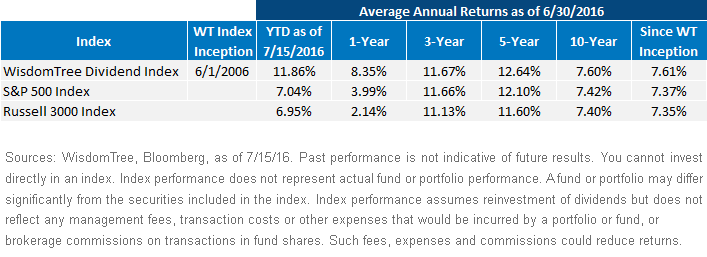What Is Driving the S&P to New Highs?



 For definitions of Indexes in the chart, visit our glossary.
While the S&P is up 7% in 2016, all 10 of the stocks listed above have advanced more than 20% this year. What’s also interesting is that they are all dividend-paying securities, and all of them, except for UnitedHealth Group, have a trailing dividend yield that is higher than the S&P 500 as a whole. And all of them, except for Chevron, have raised their dividend in the past year. This doesn’t surprise us, because in the current environment, with bond yields being sucked down toward zero through much of the developed world, global investors are seeking out companies that can pay them to own their stock and that have the fundamental strength to grow dividends in an environment where it has become more difficult to grow earnings. All 10 of these stocks have reached new 52-week highs in July, and five of them—3M, Johnson & Johnson, Altria, UnitedHealth Group and Philip Morris—have reached new all-time highs in July.
These 10 “generals of the S&P” represent about 11% of the weight of that broad-market index. However, the same 10 stocks currently represent 18% of the weight of the WisdomTree Dividend Index (click for current holdings), the broadest measure of the dividend-paying portion of the U.S. equity market. Because the WisdomTree Dividend Index includes only dividend payers—and because it rebalances annually back to relative value and weights companies based on the dividends they pay, WisdomTree is presently over-weight 9 of these 10 best-performing large-cap stocks within the S&P 500. Collectively, the WisdomTree Dividend Index is nearly 7% over-weight these top 10 stocks. That’s one of the reasons why the Index is up more than 11% this year, and why it has been able to outperform the S&P 500 by over 4.5% year-to-date through July 15.
For definitions of Indexes in the chart, visit our glossary.
While the S&P is up 7% in 2016, all 10 of the stocks listed above have advanced more than 20% this year. What’s also interesting is that they are all dividend-paying securities, and all of them, except for UnitedHealth Group, have a trailing dividend yield that is higher than the S&P 500 as a whole. And all of them, except for Chevron, have raised their dividend in the past year. This doesn’t surprise us, because in the current environment, with bond yields being sucked down toward zero through much of the developed world, global investors are seeking out companies that can pay them to own their stock and that have the fundamental strength to grow dividends in an environment where it has become more difficult to grow earnings. All 10 of these stocks have reached new 52-week highs in July, and five of them—3M, Johnson & Johnson, Altria, UnitedHealth Group and Philip Morris—have reached new all-time highs in July.
These 10 “generals of the S&P” represent about 11% of the weight of that broad-market index. However, the same 10 stocks currently represent 18% of the weight of the WisdomTree Dividend Index (click for current holdings), the broadest measure of the dividend-paying portion of the U.S. equity market. Because the WisdomTree Dividend Index includes only dividend payers—and because it rebalances annually back to relative value and weights companies based on the dividends they pay, WisdomTree is presently over-weight 9 of these 10 best-performing large-cap stocks within the S&P 500. Collectively, the WisdomTree Dividend Index is nearly 7% over-weight these top 10 stocks. That’s one of the reasons why the Index is up more than 11% this year, and why it has been able to outperform the S&P 500 by over 4.5% year-to-date through July 15.
 Dividend indexes are traditionally concentrated in the defensive sectors of the market, often exhibiting less volatility than the broader market because of the higher dividend yields they generate up front. The WisdomTree Dividend Index is no exception. It is yielding more than 3% when both the S&P 500 and the Russell 3000 Index are yielding around 2%. Over the last five years, the WisdomTree Dividend Index had a beta of just .86 relative to the S&P 500. And it is over-weight by a few percentage points to such defensive sectors as Telecommunications, Utilities and Consumer Staples relative to the S&P 500 Index as of July. Yet its ability to outperform market cap-weighted benchmarks like the S&P 500 and the Russell 3000 on both an absolute and a risk-adjusted basis since its inception in June 2006 , is yet another reminder that despite the defensive nature of dividend stocks, the WisdomTree methodology still provides the potential to capture the market’s upside when the market advances.
In fact, if one looks back over the last one, three, five and ten years, the WisdomTree Dividend Index has actually beaten the S&P 500 in each of these periods—despite growth stocks beating value stocks in the U.S. by 260 basis points annualized over the last decade. WisdomTree has seen similar outperformance in the large-cap, mid-cap and small-caps segments of the U.S. market, providing evidence that a dividend-based approach is something more than just a “value” approach to the market. The consistency of that long-term performance, coupled with the lower volatility and the higher dividend income that dividend weighting makes possible, underscores why we believe investors should consider using the dividend-paying portion of the market for their core equity exposures.
Dividend indexes are traditionally concentrated in the defensive sectors of the market, often exhibiting less volatility than the broader market because of the higher dividend yields they generate up front. The WisdomTree Dividend Index is no exception. It is yielding more than 3% when both the S&P 500 and the Russell 3000 Index are yielding around 2%. Over the last five years, the WisdomTree Dividend Index had a beta of just .86 relative to the S&P 500. And it is over-weight by a few percentage points to such defensive sectors as Telecommunications, Utilities and Consumer Staples relative to the S&P 500 Index as of July. Yet its ability to outperform market cap-weighted benchmarks like the S&P 500 and the Russell 3000 on both an absolute and a risk-adjusted basis since its inception in June 2006 , is yet another reminder that despite the defensive nature of dividend stocks, the WisdomTree methodology still provides the potential to capture the market’s upside when the market advances.
In fact, if one looks back over the last one, three, five and ten years, the WisdomTree Dividend Index has actually beaten the S&P 500 in each of these periods—despite growth stocks beating value stocks in the U.S. by 260 basis points annualized over the last decade. WisdomTree has seen similar outperformance in the large-cap, mid-cap and small-caps segments of the U.S. market, providing evidence that a dividend-based approach is something more than just a “value” approach to the market. The consistency of that long-term performance, coupled with the lower volatility and the higher dividend income that dividend weighting makes possible, underscores why we believe investors should consider using the dividend-paying portion of the market for their core equity exposures.Important Risks Related to this Article
Dividends are not guaranteed, and a company currently paying dividends may cease paying dividends at any time.



